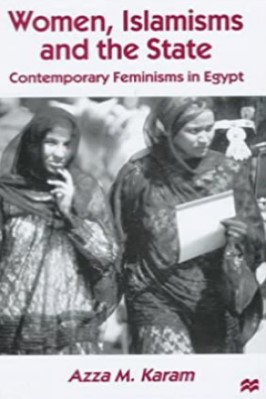Women, Islamisms and the State: Contemporary Feminisms in Egypt

| Women Islamisms And The State |
| Azza M. Karam |
| 302 |
| |
| PDF Direct Download Link |
| Click for Hard Copy from Amazon |
WOMEN ISLAMISMS AND THE STATE – Book Sample
Conclusion: Feminism, Islamisms and the State. Or: The Power of Feminisms
The journey I started, to explore the interaction between feminisms, Islamisms and the state in Egypt, has taken me among Islamist men and women activists, secular and Muslim women activists, a variety of laws and debates, and different struggles for power and hegemony.
I highlighted and analysed the power struggles between the state, with its personalized nature, and Islamists in their diversity, through the perceptions of diverse Egyptian feminists. Above all, this has been a joumey that has given prevalence to and emphasized diverse Egyptian feminisms.
I have found the most frustrating aspect in the writing of this research to be the inability to bring out all the feminist voices. Ultimately, the women I bring out here are only a fraction of the many, many feminists for whom the struggles for women’s rights are a defining aspect of their lives. And whose endeavours, both daily and long-term, have shaped, and continue to shape, much of the dynamics of hegemonic power plays.
The most enriching aspect of this project has been meeting these women again and again in the text and renewing my knowledge of them and their discourses throughout. Above all, I am fortified by being able to identify the diversity of women’s struggles, and to understand that feminisms are all the better for their differences. Both the researcher and activist aspects of me have gained in know ledge, insight and understanding.
The journey of fieldwork and writing has also meant contrasting the different textual validities of representation and discourse respectively. What the different feminists have to say about Islamism, state and feminism was presented by situating and comparing their words.
In the following pages, I summarize the salient aspects of the power dynamics between Islamisms, feminisms and the state.
it must be said that as a conclusion, it is quite a difficult chapter to write. For how can one conclude on issues that are still to this very moment relevant and ongoing dynamics? How does one sum up over 20 years of currently highly pertinent and very crucial activism? Yet I have attempted to capture a moment in the midst of these power dynamics which are constantly shifting.
The first section, therefore, maps out the different dynamics of feminisms, Islamisms and the state, primarily in terms of their relevance to and effects on the power of Egyptian feminisms. I identify the main aspects of the different Egyptian feminisms surveyed herein; briefly examine the Islamist-state dynamics; recapitulate the different Islamist viewpoints on gender relations and the ensuing feminist reactions and/or interventions. in the second section I argue for an Egyptian feminist politics of differ ence. And in the third and final section of this chapter I briefly present other possible avenues of research.
FEMINISMS – TOGETHER YET APART
By working with a postmodern definition of feminism which is based on cultural and historical specificities, as well as localization and pluri-vocality, this research has identified three main feminist streams in Egypt: secular, Islamist and Muslim.
These different feminisms remain very much within the upper and middle classes, though the Islamist streams have a potentially larger audience, owing to Islamist use of a hegemonic language of Islam, coupled with different forms of activisms that Islamism itself advocates among all social and eco nomic classes.
The term feminism has functioned as an identification technique to map out all the women who acknowledge that women are oppressed by different means and in many ways, and who actively seek to rectify this injustice by diverse methods. Though they generally rarely referred to themselves as feminists – and some strongly opposed the term – it is important to highlight the feminist consciousness these different women represented. Within each stream diversity and con textual specifici(y are represented by the different articulations of opinions.
Nevertheless, I also tried to generalize some of their aspects in order to analyse the larger power dynamics between Islamist thought, feminist activisms and state laws.
At one end of the political spectrum is secular feminism represented by the Tajammu’ Pıırty and the New Woman Research Centre (NWRC). Both cali for total equality between the sexes, attempt to ground their ideas on women’s rights outside religious frameworks and unanimously perceive Islamism as enemy No. 1, and the state as
To read more about the Women Islamisms And The State book Click the download button below to get it for free
Report broken link
Support this Website
for websites